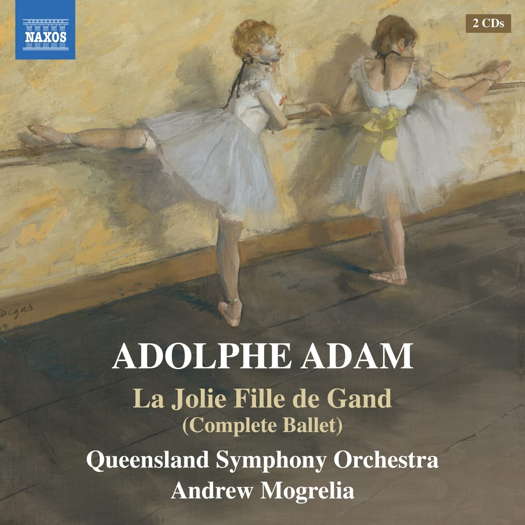 PODCAST: John Dante Prevedini leads a discussion about Classical Music and Visual Disability, including contributions from Charlotte Hardwick, Robert McCarney, Halida Dinova and Giuseppe Pennisi.
PODCAST: John Dante Prevedini leads a discussion about Classical Music and Visual Disability, including contributions from Charlotte Hardwick, Robert McCarney, Halida Dinova and Giuseppe Pennisi.
- Dvorák
- South Korean
- Philippe Graffin
- Shostakovich: The Dawn Of Humanity
- York University
- Miles Davis/Bill Evans: Blue in Green
- Siegfried Translateur
- David Leigh
PROVOCATIVE THOUGHTS: 
The late Patric Standford may have written these short pieces deliberately to provoke our feedback. If so, his success is reflected in the rich range of readers' comments appearing at the foot of most of the pages.

A Catalogue of Dreams
GERALD FENECH listens to Adolphe Adam's ballet 'La jolie fille de Gand'
'Andrew Mogrelia and his Queensland ensemble play with real gusto, and the music is made to sound less lightweight than it really is.'
Born in Paris in 1803, Adolphe Adam was the son of Louis Adam, a native of Alsace and the founder of the French school of piano playing. Louis taught at the Paris Conservatoire from 1797 until 1842, and many of his pupils became musicians of distinction. Adolphe, on the contrary, had varied schooling as a boarder, with the aim to induce the boy to take his career with greater seriousness. After private training, however, he was able in 1819 to enter the organ class of Benoist at the Conservatoire. Later his instructors were none other than Halévy, Reicha and Boieldieu, the latter also being instrumental in encouraging the young composer to continue on the journey he had decided to pursue.
In the 1820s Adam was able to earn a living as an organist while gaining experience of the theatre, first as an unpaid triangle player and later as timpanist and chorusmaster. As a composer he began to provide material for vaudevilles at the Théâtre du Gymnase in collaboration with librettist Eugène Scribe, whom he had met in Switzerland.
In 1829 he wrote his first serious work, a one-act opera called Pierre et Catherine. A year later came his first ballet, La Chatte Blanche (The White Cat), a genre he was to remain famous for. By 1832 his name was becoming ever more popular, and it was in this year that he was invited to London to provide music for a military spectacle at Covent Garden. His first international success was the opera Le postillon de Lonjumeau. In 1839 Adam travelled to St Petersburg to provide music for Filippo Taglioni and his daughter Marie, who was one of the leading ballerinas of that decade. It was in 1841 in Paris that Adam enjoyed what proved to be his greatest and lasting success, the ballet Giselle, which also launched the immortal Carlotta Grisi on her stellar career.
The project to build a new opera house for younger composers did not last long. Indeed, the disturbances of 1848 induced Adam to shut down the theatre just one year after its inauguration, and he was left in financial ruin. Despite these grave setbacks, he continued to compose and was also appointed professor of composition at the Conservatoire. By 1853 he had paid off his debts and continued working until his sudden death in 1856, aged just fifty-three.
The ballet La jolie fille de Gand followed quickly on the heels of Giselle, but the success that Adam had hoped for never came about. Indeed, while Giselle remains one of the greatest successes in ballet history, La jolie has faded into obscurity. Strange this, but in all truth, the latter work is inferior on inspiration, and while the listener comes away from Giselle whistling memorable melodies, one has to make an effort to recount what was heard in La jolie.
Listen — Adam: Introduction (La jolie fille de Gand)
(CD1 track 1, 0:00-0:34) ℗ 2000 Naxos Rights US Inc:
Mind you, I am not suggesting that there is anything amiss with this ballet. On the contrary, Adam filled it with fresh, charming and, by far and large, attractive music, but somehow the melodies do not stick. Still, I found the piece thoroughly enjoyable, if a shade too long, and I am convinced that anyone who loves ballet will surely find it agreeable to their taste.
Listen — Adam: Pas de trois (La jolie fille de Gand Act I Tableau II)
(CD1 track 11, 0:00-0:56) ℗ 2000 Naxos Rights US Inc:
La jolie fille de Gand is in three Acts and nine tableaux with choreography by Albert (Francois-Ferdinand Decombe), and a libretto by the same Decombe and Jules-Henri Vernoy de Saint-Georges. The premiere took place on 22 June 1842 at the Théâtre de l'Académie Royale de Musique, Paris, but the occasion was rather tepid. No surprise here, as the storyline has too many twists and complications and is too drawn out.
Listen — Adam: Pas de Béatrix (La jolie fille de Gand Act II Tableau II)
(CD2 track 9, 0:00-0:45) ℗ 2000 Naxos Rights US Inc:
Briefly, the plot is set in Ghent, Belgium, and concerns Beatrix, a dancer, who is betrothed to Benedict, the nephew of a rich goldsmith. Unfortunately, the Marquis of San Lucar is also after Beatrix's hand, and a series of conflicts with both men ensue. The story also includes a catalogue of dreams and an attempted elopement. As expected, by the end everything is resolved and Beatrix and Benedict get married to live happily ever after.
Listen — Adam: Après le Divertissement comique
(La jolie fille de Gand Act III Tableau III)
(CD2 track 22, 6:23-7:21) ℗ 2000 Naxos Rights US Inc:
Andrew Mogrelia and his Queensland ensemble play with real gusto, and the music is made to sound less lightweight than it really is. The recording was made in February and March 1996 by Marco Polo, but despite its age, sound quality still has that cutting edge that makes of this reissue an easy going foray into the realm of nineteenth century French ballet. Extremely pleasant, if not foot-tapping.
Copyright © 27 January 2022
Gerald Fenech,
Gzira, Malta

CD INFORMATION - ADOLPHE ADAM: LA JOLIE FILLE DE GAND
ARTICLES ABOUT NINETEENTH CENTURY MUSIC


